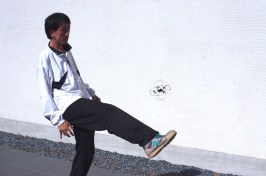
Balls are the most popular equipment for sports. To play with balls, certain physical methods, or “vocabularies”, such as throwing, hitting, spinning, or kicking have been developed by reflecting the fact that balls obey physical dynamics. While this feature forms the foundation of ball-based sports, we consider it might as well limit the possibility of them. For instance, the speed of balls could be too fast for small children, senior people, or people with physical disabilities. In this paper, we propose a flying ball based on the quadcopter technology. This ball has an ability to stay in the air, and change its location and behavior according to the sports game contexts. With this technology, physical dynamics of a ball can be re-programmed by sports designers, and new ball-playing vocabularies, such as hovering, anti-gravity, proximity, or remote manipulation, can be introduced to extend the way people interact with balls. In this paper, we introduce this concept as a method of augmenting sports, and present our initial flying ball system having a grid shell that contains a micro quadcopter, and demonstrates new sports interactions with the ball.
References
- Kei Nitta, Keita Higuchi and Jun Rekimoto, “HoverBall : Augmented Sports with a Flying Ball”, 5th International Conference on Augmented Human (AH 2014), 2014. PDF
Media
- Sony Tests a Ball That Hovers Scientific American, vol.311, issue 5, 2014
- ドローン内蔵の新世代ボール:東大チームが開発 WIRED 2014.3.25
- “ヒトは空を飛べる” 東大・ソニー・電通が挑む夢 日本経済新聞 2014.11.14
- 空中の浮き球日経サイエンス2015年1月号


